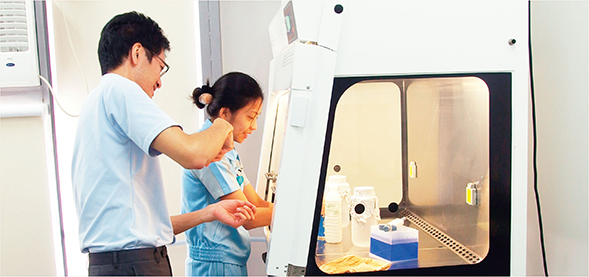MASTER TECHNIQUES from Japan to the World 4
Contribution to Countermeasures against the Growing Cases of Chronic Kidney Disease in the Philippines
—Provision of Low Protein Rice Production Technology by a Japanese Company—

An employee of Biotech Japan Corporation (left) providing instructions to local staff on how to conduct quality inspections on low protein rice (Photo: Biotech Japan Corporation)

Promoting low protein rice with an exhibition on it. It attracted attention from medical practitioners as a food that enables easy nutritional management. (Photo: Biotech Japan Corporation)
In the Philippines, the National Objectives for Health were formulated, and health and medical standards have been improved through the implementation of various measures such as the National Health Insurance Program for spreading healthcare services. However, the types of diseases that undermine public health have changed. Lifestyle-related diseases account for half of the top ten leading causes of mortality in the Philippines, and the number of people with diabetes and chronic kidney disease (CKD) caused by obesity has increased. Against this backdrop, there is a growing demand to improve diets as well as to introduce and popularize dietary therapy to counter such diseases.
Biotech Japan Corporation (BTJ), headquartered in Niigata Prefecture, has long been engaged in the research, development, and marketing of low protein rice. With the Japanese market coming into a plateau due to population decline, however, the company was exploring the possibility of expanding into foreign markets. BTJ focused on the Philippines, where it is possible to communicate in English and people consume more rice than in Japan. In 2014, BTJ visited the country to conduct a market survey on dietary therapy for diabetes and CKD patients, and came to the conclusion that the introduction of low protein rice could help the people in the Philippines improve their dietary lives. Amid the difficulties it faced in finding a local business partner that could serve as a foothold for its overseas expansion, BTJ achieved a breakthrough by utilizing JICA’s Support for Japanese Small and Medium Enterprises (SMEs) Overseas Business Development scheme (currently implemented as SDGs Business Supporting Surveys). Development of BTJ’s business was accelerated immediately after the adoption of the “Verification Survey with the Private Sector for Disseminating Japanese Technologies for Low Protein Rice for Dietary Therapy of Chronic Kidney Disease in the Philippines” by JICA. With regard to the benefits of utilizing JICA’s support scheme, Mr. EGAWA Jo, BTJ’s Chief Executive Officer, says, “Even the companies that had previously turned us away would meet with us immediately when we explained that it was a JICA project. I was surprised at the complete difference in their openness to taking appointments. It made me keenly aware of the wonderful trust that JICA has built up over the years.”
This project, implemented in cooperation with the Philippine Rice Research Institute (PhilRice), involved the production of low protein rice by using long-grain rice grown in the Philippines. However, there were many challenges in transferring Japan’s technology because of the different properties of this rice compared to short-grain rice, which is the mainstream variety in Japan. Long-grain rice has a propensity to crack when it undergoes processes to reduce protein content, which made BTJ struggle with selecting suitable varieties of long-grain rice. According to Mr. Egawa, “The hard water in the Philippines makes processing more difficult in comparison with the soft water used in Japan, and the people also have different preferences in rice flavors and textures from the Japanese people. Therefore, we produced numerous prototypes to create the exact product that suits the preferences of Filipinos.”;
As a result of these efforts, low protein rice production technology for Philippine rice was established. Efforts are now ongoing, in cooperation with the Food and Nutrition Research Institute (FNRI), to disseminate dietary therapy by explaining the effects of low protein rice to local doctors and nutritionists, among other measures. In this way, ODA provides support for the overseas expansion of SMEs as well as contributes to resolving issues in developing countries. Local doctors have expressed their appreciation with feedback such as, “We are truly happy to finally be able to realize the production of low protein rice in the Philippines.”
<< Previous Page
Main Text | Reference Statistics | Appendix | Stories from the Field | Master Techniques from Japan to the World | ODA Topics
